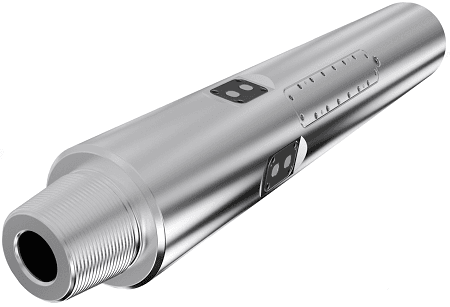The first Superior Sensor technology developed by WELL ID is the 4D Caliper, which is a Logging-While-Drilling (LWD) tool that provides exceptional accurate shape and size measurements of the borehole, both open hole wellbore and casing geometries up to 80 inches. The research, development and piloting of the 4D Caliper are supported by ConocoPhillips, Equinor, Regionalt forskningsfond Vestlandet, The Norwegian Research Council and VRI Rogaland.
© Equinor
4D Caliper
WELL ID’s 4D Caliper is a Logging-While-Drilling tool, typically placed in the Bottom Hole Assembly (BHA) for drilling operations, and provides exceptional accurate borehole shape and size measurements for both open hole wellbore and casing geometries. The accurate borehole shape and size measurements offers deeper understanding of the overburden and reservoir mechanical properties, and the same measurements are used to precisely calculate drilling fluid volume, cement volume as well as measuring casing wear, all highly important to improve well integrity and avoid well control accidents.
The 4D Caliper is a short sub, less than 1.5 meters, and has a slick outer diameter and full throughbore allowing flexibility of BHA design.
Technology behind 4D Caliper

The 4D Caliper utilizes unique nanoscale impulse radar sensors, sampled and stored at 400 times/second to provide accurate borehole shape and size. The very high sample rate and accuracy allow generation of 4D images of the wellbore and casing by combining measurements from multiple passes such as trip-in, drilling and trip-out data, to evaluate the data both in a depth domain and a time (lapse) domain.
Despite being a fundamental parameter in well construction and formation evaluation, hole size and shape is in many cases assumed to be circular and same size as drill bit due to lack of accurate caliper measurements.
4D Caliper Technology enables:
- 3D Image for exact size and shape of borehole
- 4D Image to explain development of borehole in time
- Accurate drilling fluid and cement volume
- Measurement of casing wear
Applications
The accurate borehole shape and size measurements offer deeper understanding of the overburden and reservoir mechanical properties, and the same measurements are used to precisely calculate drilling fluid volume, cement volume as well as measuring casing wear, all highly important to improve well integrity and avoid well control accidents.
© Equinor
4D Caliper can be used to:
- Optimize drilling and tubular run efficiency by providing the driller with 3D Image of exact shape of borehole to avoid sidetracks and Non-Productive Time
- Improve drilling performance by identifying cutting beds and poor hole cleaning
- Improve well integrity and cost of cement operations with accurate cement volumes
- Make better slot recovery / P&A decisions with accurate measurements of casing wear and eccentricity